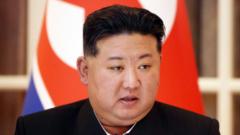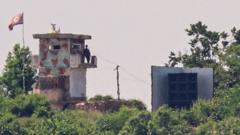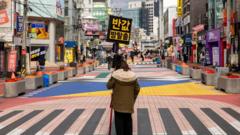Contestants at Seoul’s Space-Out Competition vie to achieve the lowest heart rate while remaining completely still and silent for 90 minutes, blending relaxation with competitive spirit.**
The Paradox of Nothingness: Inside Seoul’s Unique “Space-Out” Competition**

The Paradox of Nothingness: Inside Seoul’s Unique “Space-Out” Competition**
Participants in South Korea’s annual Space-Out Competition aim to master the art of doing nothing, but the challenge proves surprisingly complex.**
The bustling streets of Seoul played host to a peculiar event recently, the annual Space-Out Competition, one that invites participants to embrace the challenge of complete inactivity. Nestled by the serene banks of the Han River, 80 contestants—an eclectic mix of citizens—assembled to engage in a test of patience against the backdrop of society’s relentless dynamism.
As I prepared to step onto my designated pink yoga mat, my mind raced with the peculiar notion of competing in an event that celebrates doing absolutely nothing. The simple aim was to remain statue-still, adopting the zen-like state of mind that comes with zoning out. Yet, various distractions loomed large: the throbbing tension in my muscles, the commanding voice of the event announcer, and the watchful eyes of the crowd pressured me into a state of heightened alertness rather than tranquillity.
The competition format was simple yet daunting. Participants were tasked with sitting still for a full 90 minutes, interrupted only every quarter hour for pulse checks to determine who could maintain the steadiest, lowest heart rate. While one might think that achieving serenity would be a straightforward endeavor, the reality proved otherwise. As relatable as spacing out might be in our daily lives, transforming that simplicity into an art form under competitive scrutiny added significant layers of complexity.
Interestingly, many competitors admitted that their everyday lives—filled with moments of involuntary reverie—had already armed them with the necessary skills to participate. However, as I sat there, cross-legged and still, the shared experience of discomfort among participants fueled an unspoken rivalry. The ultimate victor at the end of this peculiar quest for stillness would be declared not just based on heart rates alone, but also through an audience popularity vote—an additional pressure that lent the competition an absurd yet engaging flair.
At one point, I couldn’t help but ponder: if the goal is absolute nothingness, could pursuing this aim introduce an inherent contradiction? Shouldn’t simply trying to achieve that state counteract its very essence? Such reflections carried me through the lengthy minutes, amplifying the immediate sensory responses I felt—my heart, previously racing at 116 beats per minute, mustered a fight to settle down.
In a paradoxical twist, the Space-Out Competition illustrates our societal struggle between the need for productivity and the often-overlooked benefits of rest and mental downtime. In a culture where we are incessantly bombarded by stimuli, the act of doing nothing became an ironically sought-after skill, showcasing that sometimes, to win, one must first learn to lose. As the time wore on, it became clear: the cultivation of stillness might just be the most complex competition of all.
As I prepared to step onto my designated pink yoga mat, my mind raced with the peculiar notion of competing in an event that celebrates doing absolutely nothing. The simple aim was to remain statue-still, adopting the zen-like state of mind that comes with zoning out. Yet, various distractions loomed large: the throbbing tension in my muscles, the commanding voice of the event announcer, and the watchful eyes of the crowd pressured me into a state of heightened alertness rather than tranquillity.
The competition format was simple yet daunting. Participants were tasked with sitting still for a full 90 minutes, interrupted only every quarter hour for pulse checks to determine who could maintain the steadiest, lowest heart rate. While one might think that achieving serenity would be a straightforward endeavor, the reality proved otherwise. As relatable as spacing out might be in our daily lives, transforming that simplicity into an art form under competitive scrutiny added significant layers of complexity.
Interestingly, many competitors admitted that their everyday lives—filled with moments of involuntary reverie—had already armed them with the necessary skills to participate. However, as I sat there, cross-legged and still, the shared experience of discomfort among participants fueled an unspoken rivalry. The ultimate victor at the end of this peculiar quest for stillness would be declared not just based on heart rates alone, but also through an audience popularity vote—an additional pressure that lent the competition an absurd yet engaging flair.
At one point, I couldn’t help but ponder: if the goal is absolute nothingness, could pursuing this aim introduce an inherent contradiction? Shouldn’t simply trying to achieve that state counteract its very essence? Such reflections carried me through the lengthy minutes, amplifying the immediate sensory responses I felt—my heart, previously racing at 116 beats per minute, mustered a fight to settle down.
In a paradoxical twist, the Space-Out Competition illustrates our societal struggle between the need for productivity and the often-overlooked benefits of rest and mental downtime. In a culture where we are incessantly bombarded by stimuli, the act of doing nothing became an ironically sought-after skill, showcasing that sometimes, to win, one must first learn to lose. As the time wore on, it became clear: the cultivation of stillness might just be the most complex competition of all.

















